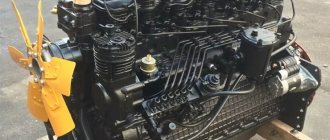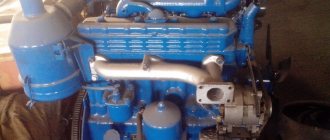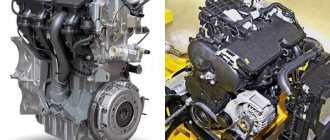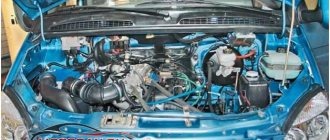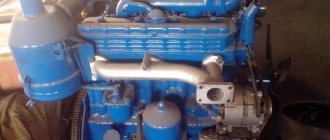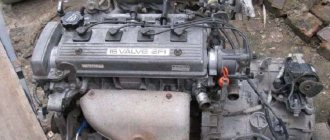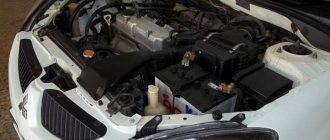The engine is the basis of any car - without it there is no movement and Drive! The engine on the Priora comes in 2 modifications: 21126 and 21127, the second is essentially a modified 126 engine, which has been installed on Lada Priora since 2013. after restyling the Lada Priora car model.
126 engines (16 valves) are high-torque after 1000 rpm, and up to 4000 - this is the maximum torque, after 4 thousand the torque decays. The 127 engine, due to the distributed air intake, pulls well from below, damping out at about the same rate as its brother. If the running-in was carried out properly, then the engine life will be close to 200 thousand km. Overhaul of the engine of a Priora car, like the entire AvtoVAZ range, is subject to the garage - there is nothing supernatural about it. The price of spare parts is more expensive than tenths, but cheaper than foreign ones. Engine power of 98 and 106 hp allows you to feel confident on the road - well, certainly not a vegetable. I consider the main 2 disadvantages of the engine to be the unit: pump roller, timing belt. If one of these spare parts fails, the valve bends. 2 minus - camshaft plugs: when these rubber bands dry out at low temperatures, they are squeezed out along with the oil. If you don’t see this in time, there will be trouble! The fact that hydraulic compensators knock when cold is considered the norm - you can close your eyes to this, there will be no harm.
In the vast majority of cases, Lada Priora cars are equipped with a 16-valve engine (the 8-valve engine was “inherited” from the “ten” and was not warmly received by car enthusiasts due to its sluggishness, but it has a huge advantage over the 16-valve engine - it does not bend valve).
The first 16 valve engine received number 126, the second – 127. The characteristics of the Priora engine No. 126 turned out to be so good and optimal that the car with this engine was sold most often. Repair of the Priora engine with 16 valves is not carried out so often, but you will have to look into it at least once every six months - in order to make sure with your own eyes that everything is in order with it. In addition, you need to keep an eye on the timing belt - if you miss this unit, you can get into big money. Read the article to the end, and we will tell you about these 2 units.
Motor 126 and 127: working life, differences
These engines on Priora had a displacement of 1.6 liters (or 1596 cm3). Optimal for city sedans, the engine size of the Lada Priora gave a good combination of dynamics and consumption: along with very decent acceleration, fuel consumption does not exceed sky-high numbers. Both engines received good marks, because the car behaved perfectly in the city and on the highway.
In fact, the 126 Priora engine became the first sixteen-valve engine for this model, and the 127 is a modified version, “overclocked” by AvtoVAZ designers. In addition to the same engine displacement, they have other identical characteristics. The in-line type of arrangement of four cylinders provides a simplified design that can be repaired on your own.
The distributed multipoint injection system is involved in creating a good, rich fuel-air mixture (a lean mixture can lead to breakdowns). The cylinder diameter is 82 mm, the piston stroke is 75.6 mm, the compression ratio is 11. The “engines” fall under the Euro 4 standard, they are powered by gasoline with an octane rating of 95.
The 126 engine for the Priora received the following characteristics: 98 hp. (72 kW at 5600 rpm), acceleration to 100 km/h in 11.5 seconds (with manual transmission), city consumption 9.1 l - 100 km (manual transmission), maximum torque - 145 Nm.
The 127 engine for the Priora was upgraded to the following figures: 106 hp. (78 kW at 5800 rpm), acceleration to 100 km/h in 11.5 seconds (with manual transmission), city consumption 8.9 liters per 100 km (with manual transmission), maximum torque – 148 Nm.
The difference may not seem so noticeable, but this is a very small but strong step in design on the part of AvtoVAZ (this is where the change to sixteen-valve “engines” with a volume of 1.6 liters ended). For a car of the Lada Priora class, the engine power was sufficient.
In the same block it is necessary to say about the operating temperature. An absolutely normal operating temperature is considered to be between 90 and 95 degrees Celsius. Further, when the car is being pushed in a traffic jam, is basking in the sun, or for some other reason, but can still work - from 97 to 110 degrees. The engine is slow in places and wears out a lot, but you can still get to your destination. A temperature below 90 degrees is a direct sign indicating that the car has not yet warmed up, and it is better to wait in place until the arrow points to the coveted 80-90 mark.
Operating a car at temperatures above 110 degrees is dangerous because the service life of the engine is noticeably reduced - hot parts undergo very severe wear, overcoming the force of friction.
In general, the service life of the Lada Priora engine with a normal driving style and careful treatment is 200,000 km - after this mark the time comes when the “engine” requires major repairs. AvtoVAZ mentioned the timing belt separately as a recommendation, saying that it needs to be checked every 100,000 km (many car enthusiasts talk about the figure of 50,000 km).
Technical characteristics of the VAZ 21127 engine
The Togliatti 127 engine produced in 2013 is a traditional 4-cylinder 16-valve engine with an injector. The cylinders operate according to the scheme 1 - 3 - 4 - 2, counting from the drive. Each cylinder has 2 intake and exhaust valves. Fuel injection is controlled by the M7.9 or January 7.2 electronic system.
The power of the unit is 78 kW or 106 horsepower. Engine 21127 reaches its maximum torque of 148 Nm at 4200 rpm. Without load, the motor runs at 800 - 850 rpm.
The 21127 engine is filled with synthetic and semi-synthetic oil with a viscosity of 5W-30 and 10W-40. Replacement will require 3 liters. It is important to observe the replacement period after 7500 - 8000 km, since the engine is equipped with hydraulic compensators that do not tolerate dirty lubricant. Oil consumption in a working unit does not exceed 0.1 l/1000 km.
According to toxicity standards 127, the engine meets Euro-4 requirements. AI-95 gasoline is suitable as fuel.
A mechanical gearbox or robot is installed in tandem with the 21127 engine. The power unit is mounted in the engine compartment on 4 supports. Brackets for mounting the supports are located on the front and rear walls of the cylinder block, as well as on the gearbox housing.
| Engine Specifications 21127 | Meaning |
| Cylinder diameter/piston stroke, mm | 82/75,6 |
| Ratio of cylinder volume to combustion chamber volume | 10,45 |
| Volume, l | 1,596 |
| Power, hp at 5800 rpm | 106 |
| Torque, Nm at 4200 rpm | 148 |
| Acceleration time to 100 km/h, s | 10,5 — 12,0 |
| Fuel consumption, l/100 km in the city | 10 |
| on the road | 6 |
| mixed | 7 |
| Fuel tank volume, l | 50 |
| Engine life, thousand km | 200 |
| Weight, kg | 116 |
Similar article ZMZ 406 engine: carburetor and injector, internal combustion engine characteristics
How much does engine 126 and 127 cost?
Engine 126 has catalog number 21126100026030, sells for about 107,000 rubles, engine 127, respectively, has catalog number 21127100026030, its price is slightly higher by 3-5 thousand rubles. The price on the secondary market will be significantly lower (up to 20-25 thousand rubles), but the savings will not pay off - a used “engine” can last no more than 1000 km, this is a real lottery.
How to find out what engine is in a Priora
You can find out by looking at the plate on the left glass of the rack, where the engine number is written on the edge. From it you can understand the 8-valve unit, or 16. You can also recognize the modification 21126 or 21127.
Signs of the need for internal combustion engine repair
The reasons why the operation of the engine is disrupted are arranged in a small list, starting with refusal to start and ending with floating idle speed (this problem was removed on the 127 “engine”). Not all breakdowns end in capital damage - sometimes it’s enough to add oil, sometimes it’s enough to adjust the ECU settings.
Compression reduction
A decrease in cylinder compression below 16 atmospheres is a bad sign. Such a high limit corresponds to a compression ratio of 11.
If the compression decreases (or vice versa increases), then the “engine” will have to be rebuilt.
Knocks in the engine
Engine knocks can come from several points. These could be hydraulic compressors, timing belt rollers or pins. The knocking noise could also be caused by low oil level. The answer to the question will be given by a thorough detailed inspection of all parts of the unit and checking the oil level.
Blue smoke from the exhaust pipe
The blue smoke that comes from the exhaust pipe appears when oil enters the combustion chamber. It can leak either from the valves or from under the piston. The result is the same: the oil is eaten up and blue smoke pours out of the chimney. Once the leak is located, half the problem will already be solved.
Troit motor
Sometimes in the cold the engine may stall - don’t be alarmed by this, because it may simply be one of the spark plugs that fails. In this case, we advise you to simply restart the engine and it will stop running.
How much does it cost to overhaul a Priora engine - average price
Self-repair of a Priora engine with 16 valves costs an average of 16-20 thousand rubles. The cost depends on the severity of the breakdown and may be lower or higher than this average range. Repairing a Priora engine can be entrusted to the wrong hands, but then you will have to pay for the work - sometimes the cost of repairs reaches as much as 40 thousand rubles.
This is an unreasonably inflated figure, because, as practice shows, you can rebuild the engine on a Priora, working at a moderate pace, in just three days - and three days of work is definitely not worth that kind of money. Don’t be afraid of not being able to cope - your Lada is easy to repair, and using the advice and “tutorials”, you will conquer even such a task that is impossible at first glance.
VAZ-21126, 1.6, 2007
Sixteen-valve 1.6 “prior engine”
Piston stroke – 75.6 mm Cylinder diameter – 82 mm Compression ratio – 11 98 hp /5600 rpm 147Nm/4300 rpm Fuel – AI95
Resource of at least 200 thousand km. In the timing system there is a belt; if the timing belt malfunctions, the valves stick to the pistons.
Quite a good engine, based on the 124th, which was “modernized” with the new ShPG, with some design solutions and reached EURO-3. Differences from 124: the crankshaft mechanism now has excellent weight distribution and balance, a piston mechanism is used with a 39% lighter weight compared to 21124, the timing belt has rollers and a belt from imported suppliers for the first time, tensioner with automatic adjustment (2112 and 21124 required tension control 2 times a year), the belt life has reached 200 thousand km, the roller life is about 100 thousand. A new water pump with improved performance has been developed. A metal composite is used as a cylinder head gasket, which practically eliminates possible burnout. The cathode collector has also been changed, and new generation ECUs are installed. The block uses plate honing with 3 diameter tolerances instead of 5. The clutch driven disc damper has been enlarged, the oil pump cover has been modified, and the original crankshaft seals have been modified.
Subsequently, the motor was subject to modifications during the production process. In particular, in response to consumer complaints regarding the SPG resource, the application of a graphite layer to the skirts and increased control over groups of pistons by diameter were introduced.
An electronic throttle unit was introduced, raising standards to EURO-4. Also during the production process, many components changed, such as engine mounts
, generators, starters, clutch, sensors. By the time engine 21127 was created, suppliers had been thoroughly shaken up, and complaints had dropped significantly. The main advantage of the 126 engine was its “torque”; with proper use and a little tuning, the engine easily tolerates high speeds. Disadvantages relative to modern competitors: sweating persisted to a lesser extent, quality of components, problems with the tightness of spark plug wells, engine diesel at 100 thousand. km of mileage due to hydraulic compensators, timing belt breakage is expensive to repair, demands on the quality of oil and gasoline, clogging of the throttle valve with soot, high cost of the timing belt, loud operation of the cathode collector, “floating” speed.
Typical breakdowns, causes, elimination
Since the 21127 motor uses a lightweight ShPG, as a result of a sudden belt break, the piston is 100% guaranteed to bend the valve. In addition, there are “diseases” characteristic of this motor:
| Power reduction | 1) burnt out valves 2) clogged air filter 3)fuel system malfunction 5) wear of camshaft cams | 1)replacement of valves 2) cleaning or replacing consumables 3) cleaning and repair 5) installation of a new camshaft |
| The internal combustion engine runs after the ignition is turned off | 1) carbon deposits inside the combustion chambers and on the valves 2) Problems with the ignition switch | 1)washing with a cleaning agent 2)replacing the ignition switch |
| Emergency pressure lamp comes on | 1) wear of the oil pump or main bearings 2) short circuit 3)low oil level | 1) replacing parts 3) adding lubricant to the level |
In principle, no special complaints were noticed with the ICE 21127; this power drive is considered reliable and economical to operate.
One of the differences
The new engine is based on the previous version of the internal combustion engine - VAZ-21126. The company did not plan to make any fundamental changes, however, there are serious differences.
The main feature is the use of a modern intake system with flaps, thanks to which air enters the cylinders a little differently. When the engine revs high, it travels a long way. At idle or low speeds, air first enters the resonance chamber. As a result, the fuel burns completely, which leads to improved performance of the VAZ-21127 engine.
Now under the hood of the car there are already 106 “horses”, although the engine volume remains the same – 1.6 liters. Moreover, this applies not only to high, but also to low speeds. And here you might think that with an increase in power, fuel consumption also increased. In fact, the efficiency remains the same. This is the same 6.7 liters per hundred kilometers.
Second feature
Another feature is the replacement of the MAF (mass air flow sensor) in favor of other devices - DBP and DTV. Thanks to the coordinated work of the duo of absolute pressure and air temperature sensors, floating speed in idle mode of the engine is not dangerous.
Otherwise, it is the same injection-type power unit with 16 valves (four for each cylinder). As for the base, the block has not undergone any changes since the VAZ-21083. The designers equipped the gas distribution mechanism drive of the Lada 21127 engine with an automatic tensioner.
Design features of the Lada 21127 engine
ICE 21127 differs from its predecessor in the variable length of the intake pipe. The intake system has a resonance chamber shifted closer to the intake valve. To control air flow, engineers installed 4 electronic dampers. Now at high speeds the air flow follows a long path, at low speeds it goes through the chamber.
Thanks to the operation of the dampers, the efficiency of fuel combustion has increased: at the time of increasing power, fuel consumption has decreased. During the compression stroke, some air is expelled from the cylinder and then returned, increasing the pressure in front of the intake manifold. At low crankshaft speeds, the 21127 engine provides torque and good throttle response. At high levels, the unit develops high power.
In addition to the dampers, engineers equipped the ICE 21127 with DTV temperature and DBP pressure sensors instead of the mass air flow sensor DMRV. New sensors transmit air flow readings to an electronic system, which enriches or leans the fuel-air mixture depending on the operating mode of the engine. In practice, budget factory tuning saved drivers from the problem of floating idle speed.
VAZ did not make any other changes in the design of the 21127 engine:
- The cylinder block is made of cast iron with subsequent honing of the internal surface. When boring, it is necessary to maintain a gap between the piston and cylinder of 0.045 mm;
- spark plug well channels and channels for heat removal are cast in the aluminum head. A 0.45 mm metal gasket is installed between the block and the head;
- The gas distribution system is built according to the DOHC scheme with two camshafts for the intake and exhaust valves. The camshafts are driven by a 22mm wide Gates timing belt with a semi-circular tooth;
- to regulate the thermal gap between the camshaft cams and valves, hydraulic compensators are installed;
- The lightweight connecting rod and piston group is manufactured by Federal Mogul. The pistons are cooled through special nozzles pressed into the main bearing supports;
- Engine lubricant is supplied under pressure to the crankshaft bearings, camshafts and hydraulic compensators. Oil is splashed onto the cylinder walls, pistons, camshafts and valve stems;
- ignition system with individual coils for each spark plug;
- fuel is supplied in a phased manner through the injectors according to a signal from the ECU.
For engine tuning 21127, experts offer:
- increase power to 115 hp. With. by installing a 54 mm damper instead of 52 mm and a 51 mm exhaust pipe with the Spider 4-2-1 system;
- replace the camshafts with Stolnikov 8.9 or similar USA, ClubTurbo, etc. to obtain power at high speeds;
- to achieve 150 hp You will need to replace the shafts with Stolnikov 9.15 with phase 316, bore the head for 31 and 27 mm valves, install Bosch 360cc or 440cc injectors.
Similar article Technical characteristics of the UAZ 469 engine
Advantages
What's so good about the new engine? There are several advantages worth highlighting here:
- All attachments are optimally located, which significantly reduces labor costs for vehicle maintenance and repair.
- Due to the special design of the intake manifold, the power unit operates in a stable mode, and the idle speed does not “float”.
- Not only the power has been significantly increased, the torque is now also greater - 148 Nm instead of 145 Nm.
The line of motors 21127 has been expanded by the manufacturer. But, perhaps, an invaluable advantage is that the engine is equipped with a new product in the form of a receiver with inertial supercharging.
Flaws
Despite the improved characteristics of the 21127 engine, there are also weaknesses. And the main disadvantage is the vulnerability of the valves. If the timing belt breaks, they can easily be bent by the pistons. Another equally pronounced disadvantage is the high cost of engine repairs. Moreover, it does not matter where and who will do this: professional service station technicians or the vehicle owners themselves.
The high cost is mainly due to the fact that the timing belt, automatic tensioner and pulley included are very expensive. This is due to the fact that they are manufactured by the foreign manufacturer Gates. The same applies to ShPG parts, which are also produced by a foreign, but different company - Federal Mogul.
Disadvantages, problems and reviews
Power increase up to 106 hp. for VAZ, this is, of course, an achievement, but budget foreign engines have already crossed the 120 hp mark: Hyundai G4FC, Renault H4M, Peugeot EC5, etc. According to driver reviews, the high power of the 21127 engine is barely noticeable, however, the tax coefficient has increased significantly.
Similar article Technical characteristics of the Moskvich 412 engine
Other disadvantages of the 127 motor are:
- bending of valves when the timing belt breaks;
- short service life and low quality ignition coils;
- the presence of a receiver in the intake system is not felt in practice;
- ECU glitches;
- noise from hydraulic compensators;
- demands on the quality of oil and gasoline.
The advantages of engine 21127 include:
- good traction from 2000-3000 rpm;
- efficiency;
- less vibrations compared to 21126;
- absence of mass air flow sensor and problems with floating speed.
Basic list of faults
As the domestic manufacturer assures, the resource of the power unit is 200 thousand kilometers while maintaining operational properties. Nevertheless, even such a perfect design of the 21127 engine does not exclude the occurrence of various malfunctions. Friction can often be observed, however, this is typical for most modern power units. This mainly indicates clogged injectors. Washing them gives the desired result.
Problems with electronics can also occur. Often the people who suffer the most are:
- ignition coil;
- starter;
- electronic control unit;
- fuel pressure or idle speed regulator.
Sometimes you can hear knocking noises from the engine compartment. You should not put off inspecting your car indefinitely; it is better to immediately determine the source of the extraneous noise. It is likely that the sounds are made by hydraulic compensators, and then there is nothing to worry about.
You should panic if the cause of the knocking is not in these parts. With a greater degree of probability, this may indicate wear of the connecting rod and piston group.
Serious damage
According to the manufacturer Gates, the service life of the timing belt is 120 thousand kilometers. However, during the operation of the 21127 engine, this is not always confirmed. In most cases, the culprit is the idler pulley, which causes the belt to break. And this already leads to more serious consequences: the valves bend. The threat of a major overhaul can be avoided by replacing the standard pistons with plug-in counterparts.
Unfortunately, the quality of domestically produced thermostats remains unchanged over time. Therefore, their breakdown is still the most common cause of car overheating. It should be noted that such an engine also does not tolerate frosts well. In this connection, some prudent drivers have to cover the radiator with cardboard during winter operation of the car.
The declared resource of 200 thousand km will justify itself only if maintenance is carried out in a timely manner and consumables are replaced.
Also, do not ignore the first signs of any malfunctions in the VAZ-21127 engine. Otherwise, you will have to prepare for capital investments. Sometimes it's easier to just buy a new car outright.
Maintenance
If you maintain your car on time, the chances that you will avoid major engine repairs are high. It is better to play it safe and avoid high costs, not only financial, but also time. A lot of nerves will also be spent.
- A timing belt can last 180 or 200 thousand kilometers, but it needs to be inspected much more often.
- The oxygen sensor has a slightly shorter service life - no more than 100 thousand km.
- The entire cooling system, like the liquid itself, will serve properly for 40 thousand kilometers.
- It is recommended to change spark plugs every 20 thousand kilometers.
- The oil filter along with the lubricant must be changed even more often - at least every 10,000 kilometers.
To perform all the listed procedures, it is not necessary to contact a service station. Regarding the VAZ-21127 engine (106 hp), all this work can be done independently in your garage, which will save the family budget.
As for fuel, he recommends filling the tank with gasoline of at least grade AI-95. And then the engine will work confidently, properly and for a long time.
Description
The new VAZ 21127 engine is based on the VAZ-21126 gasoline engine, the main engine of the Priora, and is practically no different from it.
At the same time, the new Priora engine has some features:
- The engine is equipped with an intake control system, due to which it was possible to increase its power from 98 to 106 horsepower. With a 106 hp engine, according to owners' reviews, overtaking has become calmer.
- At the same time, the torque increased slightly to 148 Nm. The increase at average speed of the 127 engine was 10 Nm, which affected the dynamic characteristics of the engine.
- The engine control controller has received new calibrations, and instead of a mass air flow sensor, a DBP (absolute pressure sensor) is used. As a result of the modification, the VAZ 21127 engine received more improved parts.
Useful tips
Since the weak link in the cooling system is the thermostat, it is necessary to carefully monitor the antifreeze temperature, which should not exceed +95...+98 °C. Otherwise, premature wear of parts cannot be avoided.
When replacing the oil filter yourself, you need to pay attention to the valve cover seal. The presence of smudges indicates an unsatisfactory technical condition of the gasket. Because of this, motors often overheat.
Some car enthusiasts prefer to increase the power of their vehicles through chip tuning. True, as a result of flashing the control unit, no special increase in power is expected - only five horsepower.
The 21127 engine can be significantly benefited by installing Stolnikov 8.9 camshafts with a phase of 280. As a result, the car will accelerate to hundreds of kilometers per hour in less time - 9 seconds. Speed lovers will be pleased.
Service
The power unit must undergo periodic maintenance every 10 thousand kilometers.
Under severe operating conditions, oil and filter changes should be carried out every 7.5 thousand. When replacing the oil filter, you should pay attention to oil leakage through the valve cover seals. This malfunction is due to the poor quality of the sealing gasket, which leads to contamination of the cooling surfaces and overheating of the motor.
A special feature of the maintenance of this engine is the periodic replacement of hydraulic valve compensators.
When operating a car with this engine, its temperature should be controlled - 95-98 degrees Celsius, otherwise the elements of the cooling system will wear out very quickly. The cause of this is usually the thermostat, which is the weak element in this system.
Removal of the exhaust pipe should be carried out with extreme caution; instead of copper nuts, the manufacturer installed steel ones; if they sour, the mounting brackets can break off. When carrying out this type of work, it is better to immediately replace these nuts with copper ones.
The worst feature of this engine is that when it fails, the engine bends the timing valve, leading to expensive repairs. Tensioning and replacing the timing belt is best done at a service center. The Lada Priora engine has 106 hp. p., according to reviews from owners, high-quality oil should be poured, otherwise the hydraulic valve compensators will fail very quickly.
The engine is also marked by knocking in the elements of the crank mechanism, main and connecting rod bearings, while the engine shakes.
Public opinion
As many owners of 2nd generation LADA Kalina cars equipped with the new engine note, they actually felt an increase in power. This was especially noticeable at low speeds. It takes 11.5 seconds to accelerate a car to a speed of 100 km/h, and this is a great merit for domestic transport.
As other reviews show, the 21127 engine worries a number of owners, which is associated with an already pressing problem - a high risk of timing belt breakage. But here you need to either come to terms with this state of affairs, or replace the pistons, as already mentioned above. A break is dangerous not only because of bent valves; other parts can also receive serious damage.
Are the valves bending?
Since the 21127 motor is built on the basis of the 21126 unit, the situation with valve bending is the same. The problem arose during the use of lightweight pistons without deep recesses on the bottoms. As a result of a broken timing belt, the camshaft stops, but the crankshaft continues to rotate by inertia, pushing the pistons up. The valve stems are bent due to a collision with the pistons, and parts can only be replaced during a major overhaul.
Knowing about the shortcoming of engine 21127, the plant initially made recommendations on maintenance regulations. Despite the declared timing belt resource of 200,000 km and an automatic tensioner, it is necessary to check the integrity of the drive and the quality of tension every maintenance. The belt can fall off not only due to natural wear, but also as a result of jamming of the idler roller or pump. In practice, the belt has to be changed after 50 - 60,000 km to prevent damage to the valve legs.
As of the fall of 2021, the question “whether the engine valves are bent” has been removed. Federal Mogul has released new non-slip pistons with full valve stroke recesses. Now owners of cars with critical engines can change the piston group and forget about the problem of a broken belt.
Modification
Thanks to the efforts of many designers, the power unit 21127 complies with the Euro-4 environmental standard. High performance indicators make it possible to equip some models from the Lad family with such an engine: Lada Priora, Lada Granta and Lada Kalina. However, the environmental standard is undergoing changes, and in connection with this, a new version of the engine was developed - 21129.
This modification of the 21127 engine complies with the Euro-5 standard, and now LADA Vesta cars and the LADA XRAY crossover are equipped with this engine.
